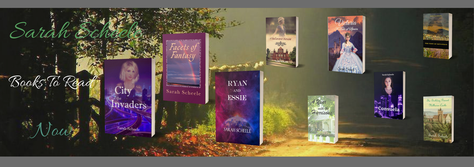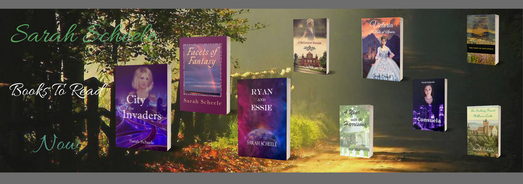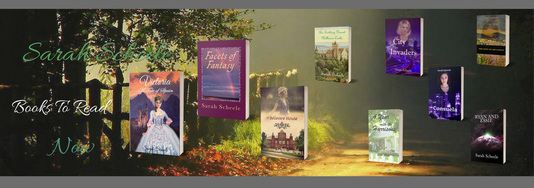Sarah Scheele's Blog, page 19
September 11, 2018
The Reinvention of Me
 Life is about making adjustments to new things. When people stop learning, they die. And I'm learning more and more as the years go on. "The best teacher, failure is," Grand Master Yoda says in Star Wars, and after my fair share of failures (of course, I think it was a little more than a fair share) I'm trying to understand readers a little more. I've always had a story--but it's important to communicate that story to people who might not be expecting to listen to it.
Life is about making adjustments to new things. When people stop learning, they die. And I'm learning more and more as the years go on. "The best teacher, failure is," Grand Master Yoda says in Star Wars, and after my fair share of failures (of course, I think it was a little more than a fair share) I'm trying to understand readers a little more. I've always had a story--but it's important to communicate that story to people who might not be expecting to listen to it. The Birthday Present has a new cover and is now at $.99 on Amazon if you want to read the teaser for The Prince's Ball. So fun--going to love working with Amethyst, her gang of friends, a trio of weird brothers from a super-snobby elevated class, and the creepy boy who has a very serious crush on Amethyst.
3 of my books (Facets of Fantasy; City of the Invaders; and Consuela are now available on a great variety of stores besides Amazon. B&N, Kobo, Tolino, many more. Facets is set to permafree so be sure to check it out. I'm going to put up a complete list of stores with a link to them all soon.
Life is so funnnnnn.
Published on September 11, 2018 13:04
September 1, 2018
From Top to Bottom
Stories aren’t static. They meet the needs of readers. I used to think a story (Little Women, for instance) was set in stone. It was what it was, with an unchanging cast of characters. But actually, stories are fluid, even old classics—let alone something new. As people come and go, losing or gaining interest in areas of the book, it changes. It metamorphoses. Suddenly bland characters are striking, “flawed” characters are seen as just evil, minor characters turn out to be the most loved of all, and good characters seem to have questionable morals. All because new people are reading the story now and they’re shedding some light on situations that might not have been noticed at first.
Oftentimes, they are seeing something that was always there—it was just the original audience didn’t quite see if a character was hiding something or if another character had potential. But as time goes on, people become more and more observant and can come up with some surprising things.
Anyway, here is a list of my books as they currently stand in popularity on the website. Since it’s been so much time after writing most of them, I’ve certainly seen some things I didn’t notice at first. Reader interaction on the website has helped me immensely as well.
City of the InvadersRyan and EssieVictoria: A Tale of SpainBellevere HouseConsuelaA Year with the HarrisonsFacets of FantasyThe Test of Devotion (it’s usually lowest, but it jumped this month)The Birthday Present w/Prince’s Ball teaser
This list isn’t a breakdown of the value of each book—only of the website visitor population. And there will be more updates.
Oftentimes, they are seeing something that was always there—it was just the original audience didn’t quite see if a character was hiding something or if another character had potential. But as time goes on, people become more and more observant and can come up with some surprising things.
Anyway, here is a list of my books as they currently stand in popularity on the website. Since it’s been so much time after writing most of them, I’ve certainly seen some things I didn’t notice at first. Reader interaction on the website has helped me immensely as well.
City of the InvadersRyan and EssieVictoria: A Tale of SpainBellevere HouseConsuelaA Year with the HarrisonsFacets of FantasyThe Test of Devotion (it’s usually lowest, but it jumped this month)The Birthday Present w/Prince’s Ball teaser
This list isn’t a breakdown of the value of each book—only of the website visitor population. And there will be more updates.

Published on September 01, 2018 08:30
August 30, 2018
End of Summer Update
Wow, it’s been an amazing 8 months since I settled down on this blog. I’ve spoken many times about redoing my books and in the last post I hinted I’m zoning in on learning about how they are viewed. One of the reasons I’ve complained about reviews in the past is that 90% of the time the reviews didn’t give me any helpful information. It’s hard for people to articulate how a book is viewed.
In any case, I’ve examined it from every angle and more and more I’ve built an image of where my books are going. Since I have more books coming in the future, it’s good to have a detailed idea of where the already published books lie—with what readers and in what degree. Each time I’ve done a new cover, I felt it couldn’t get on the website fast enough. If reviews sometimes gave me no information, the way my books appeared sometimes didn’t give the right information to readers either.
Ryan and Essie now has a lovely new cover (this is the fourth cover for this book) and I will be making a new one for The Birthday Present. Even if the story is just a footnote, I want the cover to line up with the others.As the covers grew and developed, I noticed they follow a pattern, in terms of when the story was created/published: a purple/burgundy cover; a pale green/pale yellow/white cover; and a cover with lots of black and either blue or gold. The Birthday Present needs to adjust so it doesn’t clash with the two other books in its time-frame (Facets of Fantasy and A Year with the Harrisons.)Then there will be a steady, quiet final tidying of all the books—editing quibbles, description tweaks, etc—and a new cover for City of the Invaders as I start moving 4 books onto wider platforms.
And there will be more updates.
In any case, I’ve examined it from every angle and more and more I’ve built an image of where my books are going. Since I have more books coming in the future, it’s good to have a detailed idea of where the already published books lie—with what readers and in what degree. Each time I’ve done a new cover, I felt it couldn’t get on the website fast enough. If reviews sometimes gave me no information, the way my books appeared sometimes didn’t give the right information to readers either.
Ryan and Essie now has a lovely new cover (this is the fourth cover for this book) and I will be making a new one for The Birthday Present. Even if the story is just a footnote, I want the cover to line up with the others.As the covers grew and developed, I noticed they follow a pattern, in terms of when the story was created/published: a purple/burgundy cover; a pale green/pale yellow/white cover; and a cover with lots of black and either blue or gold. The Birthday Present needs to adjust so it doesn’t clash with the two other books in its time-frame (Facets of Fantasy and A Year with the Harrisons.)Then there will be a steady, quiet final tidying of all the books—editing quibbles, description tweaks, etc—and a new cover for City of the Invaders as I start moving 4 books onto wider platforms.
And there will be more updates.
Published on August 30, 2018 08:30
August 28, 2018
When It's Really That Simple
In addition to the 50 kinds of stock characters I began to talk about in the last blog post, I’ve also found 9 different types of audience population. A character or book will each become one of the 50 “building blocks” of a story. But audience interaction is another thing altogether. This isn’t about where the character is at. It’s about what kind of person is attracted to that character.
When I had 9 books, I found that analyzing website data showed consistent levels of interest in each book—some more, some less. This reminded me of the 9 different levels I was used to dealing with in Star Wars Galaxy of Heroes. When you are working with something that’s widely popular, you’ll see a lot of indication about audience involvement—you have to know where they are and what characters they attach to.
I’ll get back to a detailed list of the 50 stock characters some other time. But the 9 levels of audience involvement are simple.Really, really liked (people LOVE this one);Safe (very much liked by many, harmless);Shady (in the hands of a person with unknown motives);Bad Egg (a touchy one with regressive, angry people);Dated Era (used to be touchy, but it just . . . feels so old now);Contested (people are arguing about this one);Lost (someone boring took it because no one else cares);Forgotten (this item was passed over and claimed by no one);Disliked (less common, but exists--actively disliked by all but one person);
I’ve found these 9 classifications to have real-world application and to be really useful.
And there will be more updates.
When I had 9 books, I found that analyzing website data showed consistent levels of interest in each book—some more, some less. This reminded me of the 9 different levels I was used to dealing with in Star Wars Galaxy of Heroes. When you are working with something that’s widely popular, you’ll see a lot of indication about audience involvement—you have to know where they are and what characters they attach to.
I’ll get back to a detailed list of the 50 stock characters some other time. But the 9 levels of audience involvement are simple.Really, really liked (people LOVE this one);Safe (very much liked by many, harmless);Shady (in the hands of a person with unknown motives);Bad Egg (a touchy one with regressive, angry people);Dated Era (used to be touchy, but it just . . . feels so old now);Contested (people are arguing about this one);Lost (someone boring took it because no one else cares);Forgotten (this item was passed over and claimed by no one);Disliked (less common, but exists--actively disliked by all but one person);
I’ve found these 9 classifications to have real-world application and to be really useful.
And there will be more updates.
Published on August 28, 2018 08:25
August 25, 2018
Frontrunners, Wallpaper, and Flops: The Different Kinds of Characters
 Now I’ve gone about viewing my books as characters—and planning new ones for next year—I applied the observations I’d had from watching many, many movies and reading many, many books. I’ve already said character repeat themselves. I’ll now be a little more detailed about that.
Now I’ve gone about viewing my books as characters—and planning new ones for next year—I applied the observations I’d had from watching many, many movies and reading many, many books. I’ve already said character repeat themselves. I’ll now be a little more detailed about that.One of the best news an author—or reader—can have is that books truly don’t have to be perfect. Except for the Bible’s author, no one has entire mastery of showing human beings and they will have their fair share of flops, boring characters, surprises, characters we hate, and characters who shouldn’t even have been there and now the readers have to try to make use of them. This means even imperfect books are fine. And it’s also fine for some to be much less interesting. Because some characters are. Not every character is a frontrunner and if my books are characters, not all of them will be in the front either. In every book are characters called “side characters,” “minor characters,” “extras,” or even the harsh “flop” and “dud.”
There are almost 50 types of stock, returning characters I’ve identified in other people’s work, and they are also in mine—within the books and even more large-scale, as the books themselves. The post is already long, I’ll just describe some broad categories and leave a really detailed list for another time.
Character who the author did not say was completely bad, but the audience thinks soCharacter who is gradually taking over reader’s attentionCharacter who was dated and shows the era the author livedCharacter who develops an annoying cult because some people hate him/herCharacter who stubbornly clings to readers because we need to understand themCharacter who wasn’t a good idea, or well-drawn, but could be recycled in some wayCharacter who is well-shown and easy to read about, but deeply disliked and troubles peopleCharacter who had literally no reason to exist and now is somehow getting an audience And there will be more updates
Published on August 25, 2018 08:30
August 23, 2018
The Characters You Don't Want to Read About
As I stated in an earlier blog post, if all of my books are to be viewed as characters within an OVERALL story, it is very important to at least try to examine even the ones you don’t instantly feel like reading. For readers this must feel like a lot of extra work. But to return to the metaphor of LOTR, this was a long franchise of very, very long movies. HOURS. And HOURS. And along the way there are loads of characters (and battles!) that any one person would much rather skip. It takes a lot of dedication to watch the whole thing through even once.
But if you just skipped to a few scenes with Aragorn, mostly in ROTK, without ever learning much about the world, you honestly don’t have him in context as a character. You could come to a lot of conclusions about him that are invalid, drawn from the little you’ve seen. That’s fun to do and it feels much more natural since you’re interested in him. It’s also fine to do that once you do know the whole story. Doing it from the first is not a good idea because you can misunderstand everything.
This skimming approach has permeated my readers from the first. It now makes sense, in the light of viewing my books as characters they feel drawn to or not, in a very instinctive way. But it created a lot of poor communication that I didn’t even understand until I put all the books side by side. People just took a book—such as Alyce or Bellevere House or Facets of Fantasy (or just one story in Facets)—and decided it was representative of me. They could form an opinion very quickly and keep that opinion. That book didn’t “represent” me at all, any more than LOTR is exclusively about Galadriel. If you watch her scenes, you know what LOTR is about period. You don’t even have to pretend to watch the rest. This is not true.
And there will be more updates.
But if you just skipped to a few scenes with Aragorn, mostly in ROTK, without ever learning much about the world, you honestly don’t have him in context as a character. You could come to a lot of conclusions about him that are invalid, drawn from the little you’ve seen. That’s fun to do and it feels much more natural since you’re interested in him. It’s also fine to do that once you do know the whole story. Doing it from the first is not a good idea because you can misunderstand everything.
This skimming approach has permeated my readers from the first. It now makes sense, in the light of viewing my books as characters they feel drawn to or not, in a very instinctive way. But it created a lot of poor communication that I didn’t even understand until I put all the books side by side. People just took a book—such as Alyce or Bellevere House or Facets of Fantasy (or just one story in Facets)—and decided it was representative of me. They could form an opinion very quickly and keep that opinion. That book didn’t “represent” me at all, any more than LOTR is exclusively about Galadriel. If you watch her scenes, you know what LOTR is about period. You don’t even have to pretend to watch the rest. This is not true.
And there will be more updates.
Published on August 23, 2018 08:30
August 21, 2018
The Books Are People Too
A simple, logical approach to my books is like this: they ARE the characters I write about. The books are actually characters in a story that is only just now beginning to take shape. Each of them draws from different times in my life and different situations I’ve seen. Almost none of them contain anything really autobiographical, but they do take the faces of people I became aware of at the time of writing the story.
When I’d published 3 books, essentially, I’d only written a short story. Each whole book was a character and a short story might have perhaps 3 characters. Now that I have 9 and I’ve devoted some attention to which “characters” they might be, I’m sure some of the best books are still to come. The rule of thumb I use for casting the people within the book is that the central MC holds the book’s essential personality. The MC determines what “character” the book becomes in the overall world of my stories. I also examine the story’s other characters in great detail to form a composite picture so I get an idea of what people are seeing.
Reading one of the books is like choosing to focus on that particular character within a movie. It is the book ABOUT that character—that character’s story. So if you pick it to read, you’re following that character more. Especially if a movie is a long saga, there are many plot threads any specific person won’t find interesting. They gravitate towards a couple of characters and mostly follow their stories. I think it is a better idea to gain a more developed idea of what story I’m telling instead of just forming conclusions about one book, as it is to watch a whole movie BEFORE you zone in on a person you like.
And there will be more updates.
When I’d published 3 books, essentially, I’d only written a short story. Each whole book was a character and a short story might have perhaps 3 characters. Now that I have 9 and I’ve devoted some attention to which “characters” they might be, I’m sure some of the best books are still to come. The rule of thumb I use for casting the people within the book is that the central MC holds the book’s essential personality. The MC determines what “character” the book becomes in the overall world of my stories. I also examine the story’s other characters in great detail to form a composite picture so I get an idea of what people are seeing.
Reading one of the books is like choosing to focus on that particular character within a movie. It is the book ABOUT that character—that character’s story. So if you pick it to read, you’re following that character more. Especially if a movie is a long saga, there are many plot threads any specific person won’t find interesting. They gravitate towards a couple of characters and mostly follow their stories. I think it is a better idea to gain a more developed idea of what story I’m telling instead of just forming conclusions about one book, as it is to watch a whole movie BEFORE you zone in on a person you like.
And there will be more updates.
Published on August 21, 2018 15:48
August 18, 2018
The Case of the Mystery Readers
Ryan and Essie is going to get a new cover and The Prince’s Ball has a slight world-switch. I’ll detail those soon. But I promised to explore a bit of mystery in my plots, so I’ll do that here.
For the record, I’ve usually found mystery a genre worth little attention. At times, I’ve even thought of it as remarkably boring because it emphasizes plot (the mystery and its elements) over characters, love stories, adventure, philosophy, or any other type of situation. In fact, saying you’re reading a mystery is just saying, “I’m reading a book with a, like, plot.” Even if the characters have quirks or relationships, they are only for developing the mystery. The characters don’t exist independently of the plot’s needs. Of course, all my stories have mystery because they have things for the characters to find out. Characters who know everything already are like people who do—insufferable.
Because plots are the skeleton of a book, not its flesh and blood, I hadn’t thought of that element as singled out on its own. But I’m aware a lot of people read this way. So I’ll clarify that yes, mystery is important to my work. It’s just not the only thing. Facets of Fantasy, for instance, has 5 stories and every one has a strong mystery plot. Each world holds a secret inside it that the characters uncover. But I don’t call it Facets of Mystery because that’s not the only reason to read the book.
And there will be more updates
For the record, I’ve usually found mystery a genre worth little attention. At times, I’ve even thought of it as remarkably boring because it emphasizes plot (the mystery and its elements) over characters, love stories, adventure, philosophy, or any other type of situation. In fact, saying you’re reading a mystery is just saying, “I’m reading a book with a, like, plot.” Even if the characters have quirks or relationships, they are only for developing the mystery. The characters don’t exist independently of the plot’s needs. Of course, all my stories have mystery because they have things for the characters to find out. Characters who know everything already are like people who do—insufferable.
Because plots are the skeleton of a book, not its flesh and blood, I hadn’t thought of that element as singled out on its own. But I’m aware a lot of people read this way. So I’ll clarify that yes, mystery is important to my work. It’s just not the only thing. Facets of Fantasy, for instance, has 5 stories and every one has a strong mystery plot. Each world holds a secret inside it that the characters uncover. But I don’t call it Facets of Mystery because that’s not the only reason to read the book.
And there will be more updates
Published on August 18, 2018 08:30
August 16, 2018
From Arnea to Talvira: A Decade of Me
 Since I roughly have a book for every year I’ve been writing, I now have a few “characters” to play around with. The cast of books isn’t complete, of course, and I have many more books planned. Every good story told is essentially the same one over and over. It has the exact same arcs, types of situations, strong areas, weak areas, weird areas, things that need to be brought out more, parts that are misunderstood and can help explore someone’s psychology, etc.
Since I roughly have a book for every year I’ve been writing, I now have a few “characters” to play around with. The cast of books isn’t complete, of course, and I have many more books planned. Every good story told is essentially the same one over and over. It has the exact same arcs, types of situations, strong areas, weak areas, weird areas, things that need to be brought out more, parts that are misunderstood and can help explore someone’s psychology, etc.Although I don’t have all the “characters” yet, I have 9 by now, with each book being like a character in a larger story. I actually expect people to be interested in just one or two, because that’s how they respond to characters. (That puts my mind at ease about genre writing, which like many authors I’d viewed as a sort of necessity. But writing genre would have every book be the same, which would be like showing the exact same character over and over and over and over.)
Here’s a list of them:The Birthday Present (with Prince’s Ball teaser) The teaser has been updated as I’ve changed the setting of the Prince’s Ball to The Birthday Present world. It was easy to do this. More on that later.Facets of FantasyA Year with the Harrisons (republished 2018)Facets of Fantasy extras (I did another version of the book and a couple of story singles)Ryan and EssieCity of the InvadersVictoria: A Tale of SpainThe Test of DevotionBellevere HouseConsuela (the old ebook was barely read at all and the rewrite this year is so total that it’s a new book, so I’ll put it here) And there will be more updates.
Published on August 16, 2018 08:30
August 14, 2018
Getting to Know My People
Once I decided each of my books was part of one long story, the task has become deciding what pieces go where rather than whether some pieces should go and some stay. I find that people don’t tend to be good listeners, but it’s not easy for me to assign a visual personality to my work. However, I found a way around this communication problem once I started to think of the BOOKS as characters in their own right.
Within each book I started casting the characters as actors, but I also began to view the books individually as if they were characters too. Reading the book is like starting to zone in on and actually listen to a character you are interested in. Skimming a book is like skimming over a character’s scenes, maybe you like one or two, but you’re actually trying to not to get involved. Complaining about a book tends to mean you feel threatened or cheated when it’s not for you—as with complaining about a character.
I now make posters arranging book covers as if they were people’s faces. It helps me pinpoint what book would draw in which person.
And there will be more updates.
Within each book I started casting the characters as actors, but I also began to view the books individually as if they were characters too. Reading the book is like starting to zone in on and actually listen to a character you are interested in. Skimming a book is like skimming over a character’s scenes, maybe you like one or two, but you’re actually trying to not to get involved. Complaining about a book tends to mean you feel threatened or cheated when it’s not for you—as with complaining about a character.
I now make posters arranging book covers as if they were people’s faces. It helps me pinpoint what book would draw in which person.
And there will be more updates.
Published on August 14, 2018 13:05



